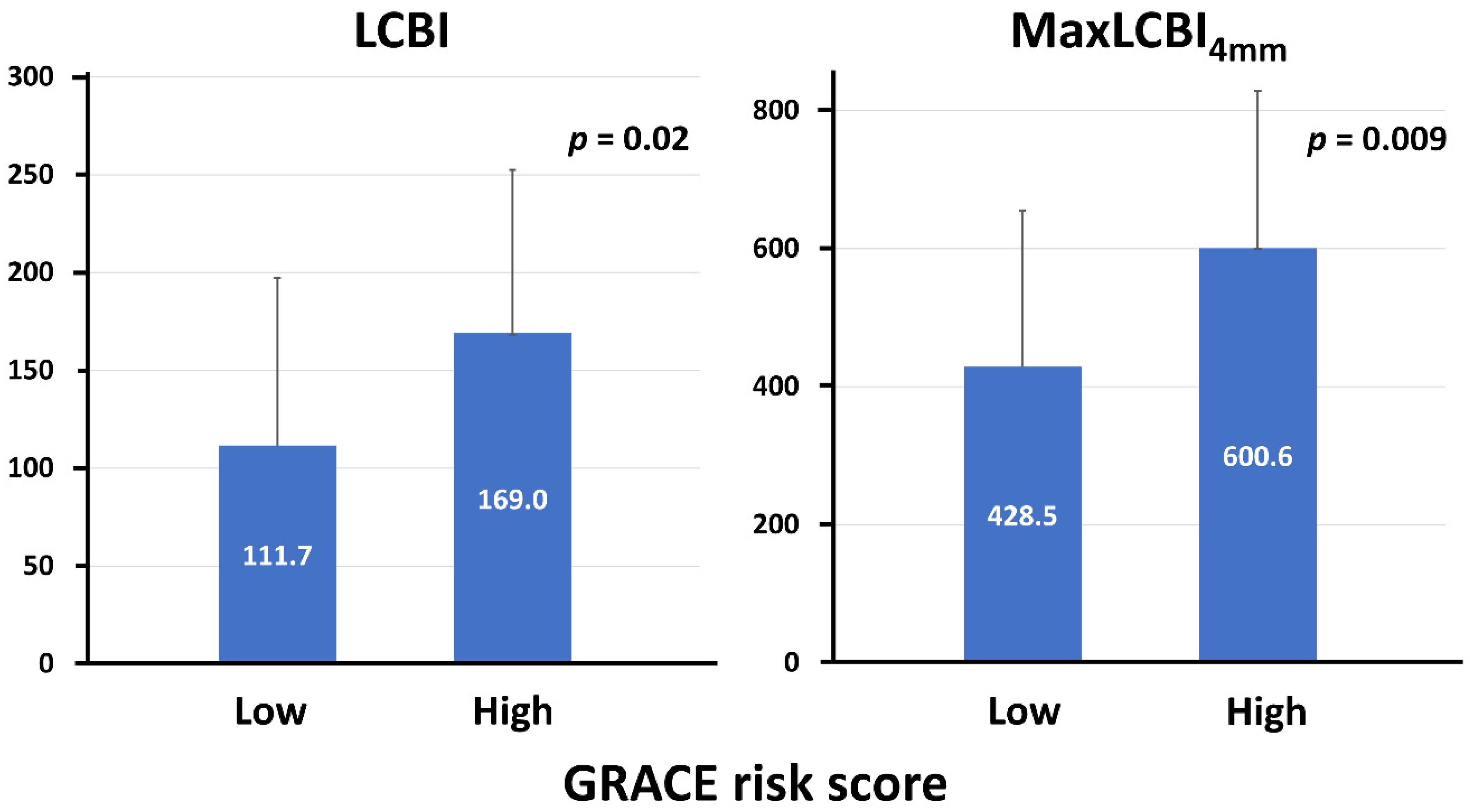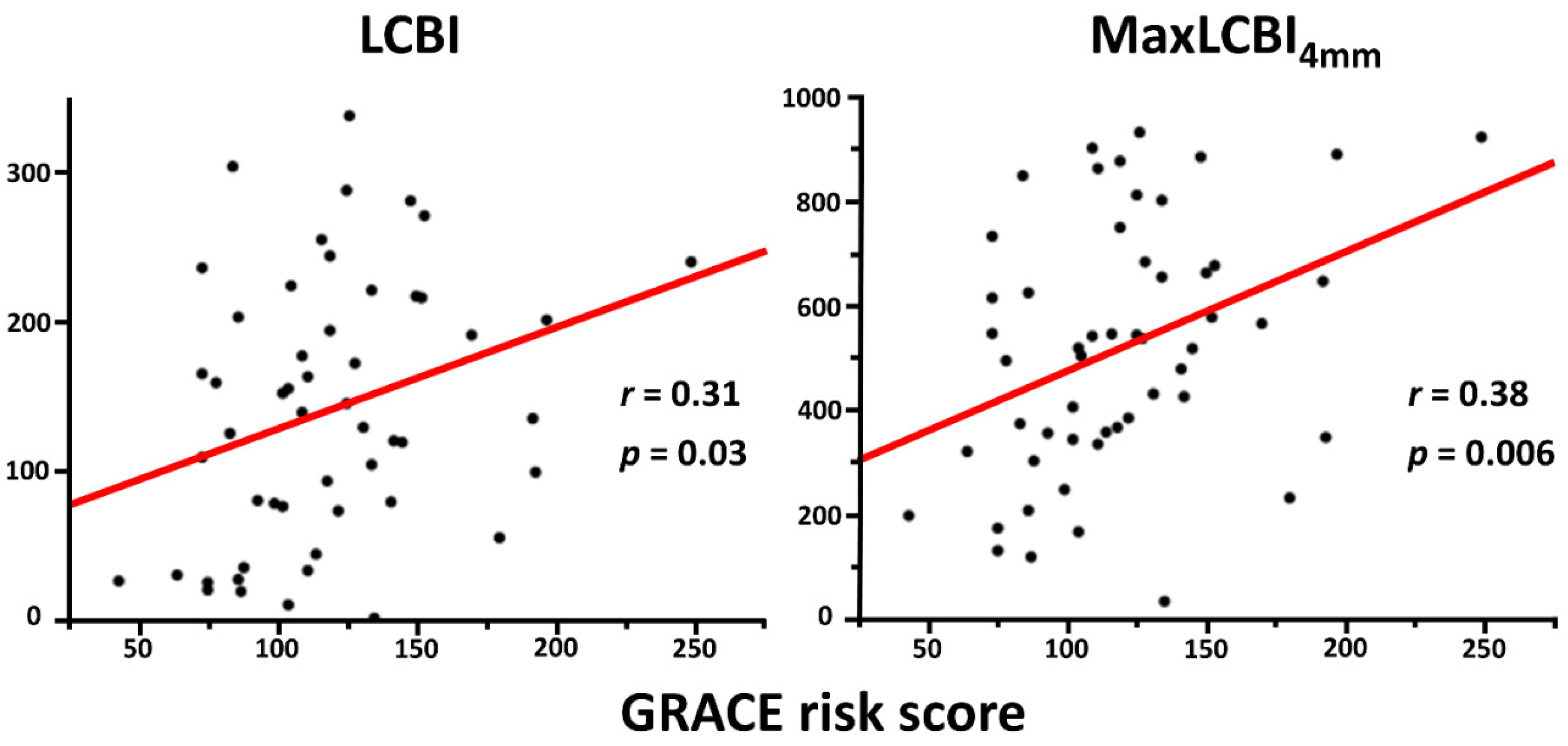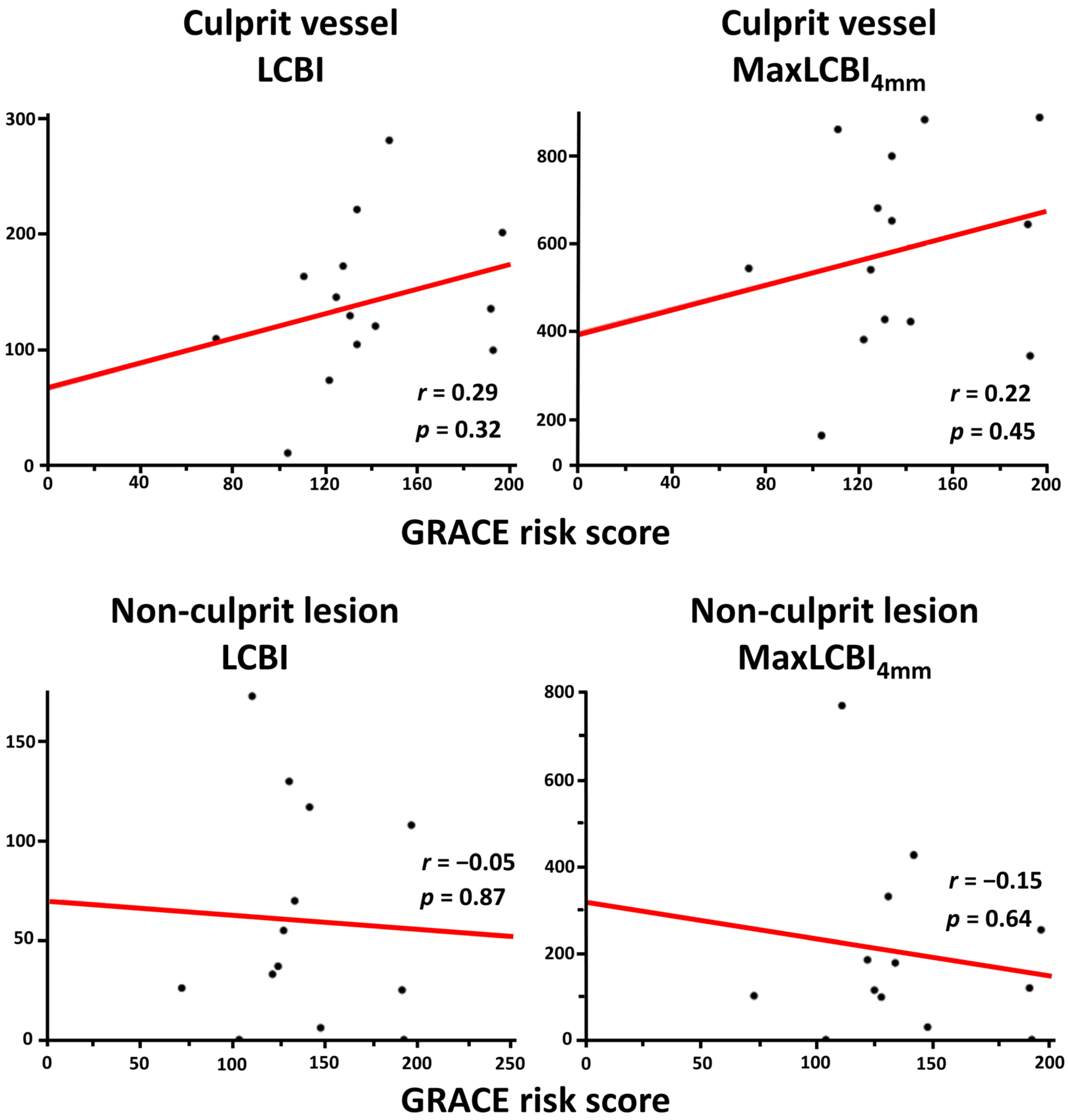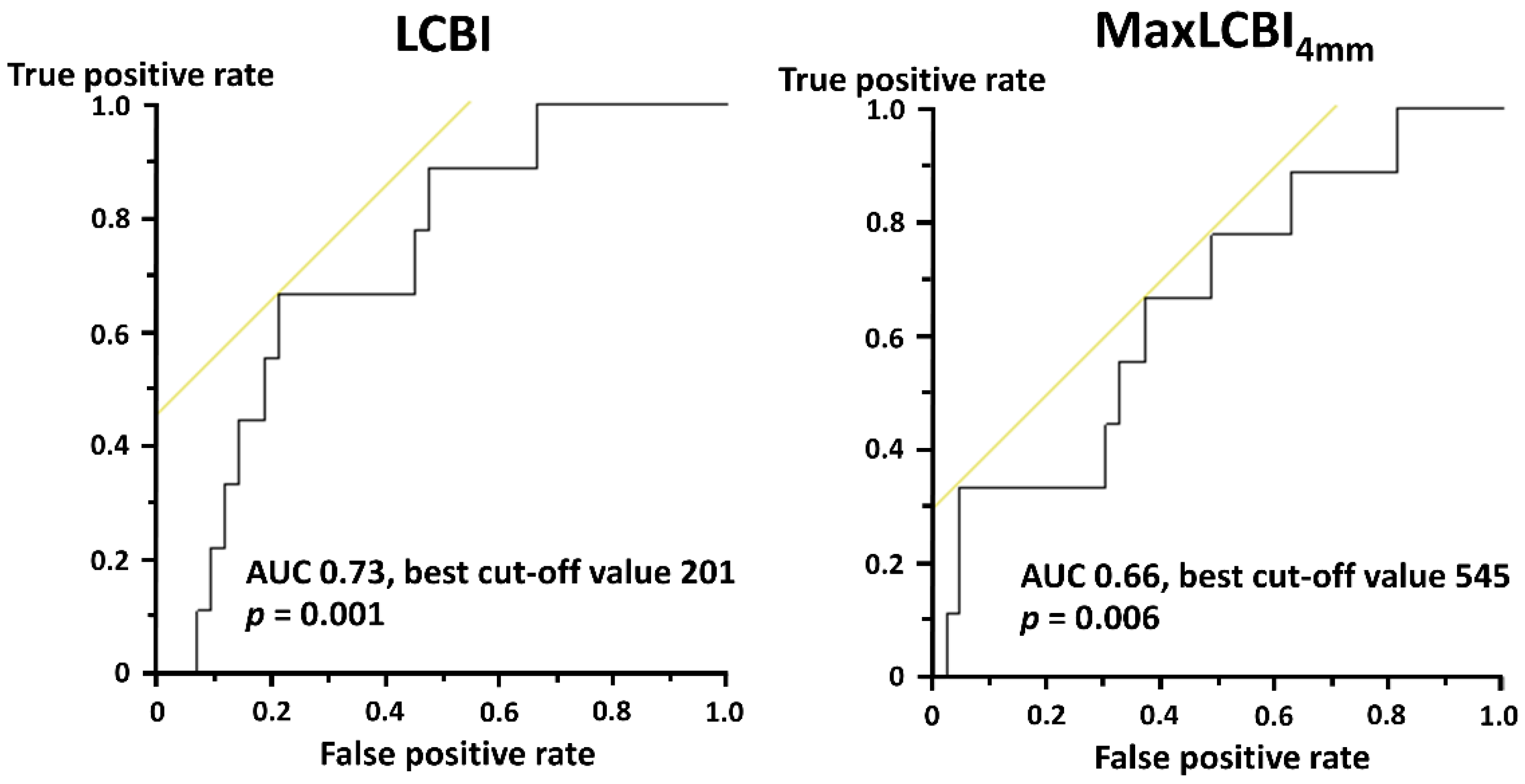Relation of GRACE Risk Score to Coronary Lipid Core Plaques in Patients with Acute Coronary Syndrome
Abstract
1. Introduction
2. Materials and Methods
2.1. Study Population
2.2. GRACE Risk Score
2.3. NIRS-IVUS Imaging
2.4. Definitions
2.5. Endpoint and Statistical Analysis
3. Results
4. Discussion
4.1. Relation between GRACE Risk Score and Lipid Plaques
4.2. GRACE Risk Score Guided Management
4.3. Study Limitations
5. Conclusions
Author Contributions
Funding
Institutional Review Board Statement
Informed Consent Statement
Data Availability Statement
Conflicts of Interest
References
- Granger, C.B.; Goldberg, R.J.; Dabbous, O.; Pieper, K.S.; Eagle, K.A.; Cannon, C.P.; Van De Werf, F.; Avezum, A.; Goodman, S.G.; Flather, M.D.; et al. Global Registry of Acute Coronary Events Investigators. Predictors of hospital mortality in the global registry of acute coronary events. Arch. Intern. Med. 2003, 163, 2345–2353. [Google Scholar] [CrossRef] [PubMed]
- Ibanez, B.; James, S.; Agewall, S.; Antunes, M.J.; Bucciarelli-Ducci, C.; Bueno, H.; Caforio, A.L.P.; Crea, F.; Goudevenos, J.A.; Halvorsen, S.; et al. 2017 ESC Guidelines for the management of acute myocardial infarction in patients presenting with ST-segment elevation: The Task Force for the management of acute myocardial infarction in patients presenting with ST-segment elevation of the European Society of Cardiology (ESC). Eur. Heart J. 2018, 39, 119–177. [Google Scholar]
- Collet, J.P.; Thiele, H.; Barbato, E.; Barthélémy, O.; Bauersachs, J.; Bhatt, D.L.; Dendale, P.; Dorobantu, M.; Edvardsen, T.; Folliguet, T.; et al. 2020 ESC Guidelines for the management of acute coronary syndromes in patients presenting without persistent ST-segment elevation. Eur. Heart J. 2021, 42, 1289–1367. [Google Scholar] [CrossRef]
- D’Ascenzo, F.; Biondi-Zoccai, G.; Moretti, C.; Bollati, M.; Omedè, P.; Sciuto, F.; Presutti, D.G.; Modena, M.G.; Gasparini, M.; Reed, M.J.; et al. TIMI, GRACE and alternative risk scores in Acute Coronary Syndromes: A meta-analysis of 40 derivation studies on 216,552 patients and of 42 validation studies on 31,625 patients. Contemp. Clin. Trials 2012, 33, 507–514. [Google Scholar] [CrossRef]
- Mitarai, T.; Tanabe, Y.; Akashi, Y.J.; Maeda, A.; Ako, J.; Ikari, Y.; Ebina, T.; Namiki, A.; Fukui, K.; Michishita, I.; et al. A novel risk stratification system “Angiographic GRACE Score” for predicting in-hospital mortality of patients with acute myocardial infarction: Data from the K-ACTIVE Registry. J. Cardiol. 2021, 77, 179–185. [Google Scholar] [CrossRef] [PubMed]
- Sato, T.; Saito, Y.; Matsumoto, T.; Yamashita, D.; Saito, K.; Wakabayashi, S.; Kitahara, H.; Sano, K.; Kobayashi, Y. Impact of CADILLAC and GRACE risk scores on short- and long-term clinical outcomes in patients with acute myocardial infarction. J. Cardiol. 2021, 78, 201–205. [Google Scholar] [CrossRef]
- Mehta, S.R.; Granger, C.B.; Boden, W.E.; Steg, P.G.; Bassand, J.P.; Faxon, D.P.; Afzal, R.; Chrolavicius, S.; Jolly, S.S.; Widimsky, P.; et al. Early versus delayed invasive intervention in acute coronary syndromes. N. Engl. J. Med. 2009, 360, 2165–2175. [Google Scholar] [CrossRef]
- Kofoed, K.F.; Kelbæk, H.; Hansen, P.R.; Torp-Pedersen, C.; Høfsten, D.; Kløvgaard, L.; Holmvang, L.; Helqvist, S.; Jørgensen, E.; Galatius, S.; et al. Early Versus Standard Care Invasive Examination and Treatment of Patients With Non-ST-Segment Elevation Acute Coronary Syndrome. Circulation 2018, 138, 2741–2750. [Google Scholar] [CrossRef] [PubMed]
- Fox, K.A.; Dabbous, O.H.; Goldberg, R.J.; Pieper, K.S.; Eagle, K.A.; Van de Werf, F.; Avezum, A.; Goodman, S.G.; Flather, M.D.; Anderson, F.A., Jr.; et al. Prediction of risk of death and myocardial infarction in the six months after presentation with acute coronary syndrome: Prospective multinational observational study (GRACE). BMJ 2006, 333, 1091. [Google Scholar] [CrossRef] [PubMed]
- Littnerova, S.; Kala, P.; Jarkovsky, J.; Kubkova, L.; Prymusova, K.; Kubena, P.; Tesak, M.; Toman, O.; Poloczek, M.; Spinar, J.; et al. GRACE Score among Six Risk Scoring Systems (CADILLAC, PAMI, TIMI, Dynamic TIMI, Zwolle) Demonstrated the Best Predictive Value for Prediction of Long-Term Mortality in Patients with ST-Elevation Myocardial Infarction. PLoS ONE 2015, 10, e0123215. [Google Scholar] [CrossRef]
- Davies, M.J. The pathophysiology of acute coronary syndromes. Heart 2000, 83, 361–366. [Google Scholar] [CrossRef]
- Falk, E.; Shah, P.K.; Fuster, V. Coronary plaque disruption. Circulation 1995, 92, 657–671. [Google Scholar] [CrossRef] [PubMed]
- Virmani, R.; Kolodgie, F.D.; Burke, A.P.; Farb, A.; Schwartz, S.M. Lessons from sudden coronary death: A comprehensive morphological classification scheme for atherosclerotic lesions. Arterioscler. Thromb. Vasc. Biol. 2000, 20, 1262–1275. [Google Scholar] [CrossRef] [PubMed]
- Wang, S.; Xiu, J.; Liao, W.; Liao, Y.; Bin, J. Relative Effect of Current Intensive Lipid-Lowering Drugs on Cardiovascular Outcomes in Secondary Prevention—A Meta-Analysis of 12 Randomized Trials. Circ. J. 2019, 83, 1356–1367. [Google Scholar] [CrossRef] [PubMed]
- Sofidis, G.; Otountzidis, N.; Stalikas, N.; Karagiannidis, E.; Papazoglou, A.S.; Moysidis, D.V.; Panteris, E.; Deda, O.; Kartas, A.; Zegkos, T.; et al. Association of GRACE Risk Score with Coronary Artery Disease Complexity in Patients with Acute Coronary Syndrome. J. Clin. Med. 2021, 10, 2210. [Google Scholar] [CrossRef]
- Rahmani, R.; Majidi, B.; Ariannejad, H.; Shafiee, A. The Value of the GRACE Score for Predicting the SYNTAX Score in Patients with Unstable Angina/Non-ST Elevation Myocardial Infarction. Cardiovasc. Revasc. Med. 2020, 21, 514–517. [Google Scholar] [CrossRef]
- Cakar, M.A.; Sahinkus, S.; Aydin, E.; Vatan, M.B.; Keser, N.; Akdemir, R.; Gunduz, H. Relation between the GRACE score and severity of atherosclerosis in acute coronary syndrome. J. Cardiol. 2014, 63, 24–28. [Google Scholar] [CrossRef]
- Oemrawsingh, R.M.; Cheng, J.M.; García-García, H.M.; van Geuns, R.J.; de Boer, S.P.; Simsek, C.; Kardys, I.; Lenzen, M.J.; van Domburg, R.T.; Regar, E.; et al. Near-infrared spectroscopy predicts cardiovascular outcome in patients with coronary artery disease. J. Am. Coll. Cardiol. 2014, 64, 2510–2518. [Google Scholar] [CrossRef]
- Schuurman, A.S.; Vroegindewey, M.; Kardys, I.; Oemrawsingh, R.M.; Cheng, J.M.; de Boer, S.; Garcia-Garcia, H.M.; van Geuns, R.J.; Regar, E.S.; Daemen, J.; et al. Near-infrared spectroscopy-derived lipid core burden index predicts adverse cardiovascular outcome in patients with coronary artery disease during long-term follow-up. Eur. Heart J. 2018, 39, 295–302. [Google Scholar] [CrossRef]
- Waksman, R.; Di Mario, C.; Torguson, R.; Ali, Z.A.; Singh, V.; Skinner, W.H.; Artis, A.K.; Cate, T.T.; Powers, E.; Kim, C.; et al. Identification of patients and plaques vulnerable to future coronary events with near-infrared spectroscopy intravascular ultrasound imaging: A prospective, cohort study. Lancet 2019, 394, 1629–1637. [Google Scholar] [CrossRef]
- Erlinge, D.; Maehara, A.; Ben-Yehuda, O.; Bøtker, H.E.; Maeng, M.; Kjøller-Hansen, L.; Engstrøm, T.; Matsumura, M.; Crowley, A.; Dressler, O.; et al. Identification of vulnerable plaques and patients by intracoronary near-infrared spectroscopy and ultrasound (PROSPECT II): A prospective natural history study. Lancet 2021, 397, 985–995. [Google Scholar] [CrossRef] [PubMed]
- Thygesen, K.; Alpert, J.S.; Jaffe, A.S.; Chaitman, B.R.; Bax, J.J.; Morrow, D.A.; White, H.D. Fourth Universal Definition of Myocardial Infarction (2018). J. Am. Coll. Cardiol. 2018, 72, 2231–2264. [Google Scholar] [CrossRef] [PubMed]
- Braunwald, E. Unstable angina. A classification. Circulation 1989, 80, 410–414. [Google Scholar] [CrossRef] [PubMed]
- Fox, K.A.; Fitzgerald, G.; Puymirat, E.; Huang, W.; Carruthers, K.; Simon, T.; Coste, P.; Monsegu, J.; Gabriel Steg, P.; Danchin, N.; et al. Should patients with acute coronary disease be stratified for management according to their risk? Derivation, external validation and outcomes using the updated GRACE risk score. BMJ Open 2014, 4, e004425. [Google Scholar] [CrossRef]
- Suzuki, N.; Asano, T.; Nakazawa, G.; Aoki, J.; Tanabe, K.; Hibi, K.; Ikari, Y.; Kozuma, K. Clinical expert consensus document on quantitative coronary angiography from the Japanese Association of Cardiovascular Intervention and Therapeutics. Cardiovasc. Interv. Ther. 2020, 35, 105–116. [Google Scholar] [CrossRef]
- Ozaki, Y.; Hara, H.; Onuma, Y.; Katagiri, Y.; Amano, T.; Kobayashi, Y.; Muramatsu, T.; Ishii, H.; Kozuma, K.; Tanaka, N.; et al. CVIT expert consensus document on primary percutaneous coronary intervention (PCI) for acute myocardial infarction (AMI) update 2022. Cardiovasc. Interv. Ther. 2022, 37, 1–34. [Google Scholar] [CrossRef]
- Saito, Y.; Kobayashi, Y. Contemporary coronary drug-eluting and coated stents: A mini-review. Cardiovasc. Interv. Ther. 2021, 36, 20–22. [Google Scholar] [CrossRef]
- Sakamoto, K.; Sato, R.; Tabata, N.; Ishii, M.; Yamashita, T.; Nagamatsu, S.; Motozato, K.; Yamanaga, K.; Hokimoto, S.; Sueta, D.; et al. Temporal trends in coronary intervention strategies and the impact on one-year clinical events: Data from a Japanese multi-center real-world cohort study. Cardiovasc. Interv. Ther. 2022, 37, 66–77. [Google Scholar] [CrossRef]
- Takeuchi, M.; Dohi, T.; Fukase, T.; Nishio, R.; Takahashi, N.; Endo, H.; Doi, S.; Kato, Y.; Okai, I.; Iwata, H.; et al. Comparison of clinical outcomes between percutaneous coronary intervention for de novo lesions versus in-stent restenosis lesions. Cardiovasc. Interv. Ther. 2022, 37, 324–332. [Google Scholar] [CrossRef]
- Yoshida, H.; Sakakura, K.; Yamamoto, K.; Taniguchi, Y.; Tsukui, T.; Seguchi, M.; Jinnouchi, H.; Wada, H.; Moriya, T.; Fujita, H. Comparison of in-hospital death following ST-elevation myocardial infarction between secondary emergency and tertiary emergency. Cardiovasc. Interv. Ther. 2021, 36, 444–451. [Google Scholar] [CrossRef]
- Stone, G.W.; Maehara, A.; Muller, J.E.; Rizik, D.G.; Shunk, K.A.; Ben-Yehuda, O.; Genereux, P.; Dressler, O.; Parvataneni, R.; Madden, S.; et al. Plaque Characterization to Inform the Prediction and Prevention of Periprocedural Myocardial Infarction During Percutaneous Coronary Intervention: The CANARY Trial (Coronary Assessment by Near-infrared of Atherosclerotic Rupture-prone Yellow). JACC Cardiovasc. Interv. 2015, 8, 927–936. [Google Scholar] [CrossRef] [PubMed]
- Tateishi, K.; Kitahara, H.; Saito, Y.; Kadohira, T.; Saito, K.; Matsuoka, T.; Mori, N.; Nakayama, T.; Fujimoto, Y.; Kobayashi, Y. Impact of clinical presentations on lipid core plaque assessed by near-infrared spectroscopy intravascular ultrasound. Int. J. Cardiovasc. Imaging 2021, 37, 1151–1158. [Google Scholar] [CrossRef]
- Saito, Y.; Kobayashi, Y.; Fujii, K.; Sonoda, S.; Tsujita, K.; Hibi, K.; Morino, Y.; Okura, H.; Ikari, Y.; Honye, J. Clinical expert consensus document on intravascular ultrasound from the Japanese Association of Cardiovascular Intervention and Therapeutics (2021). Cardiovasc. Interv. Ther. 2022, 37, 40–51. [Google Scholar] [CrossRef] [PubMed]
- Ando, H.; Yamaji, K.; Kohsaka, S.; Ishii, H.; Wada, H.; Yamada, S.; Sawano, M.; Inohara, T.; Numasawa, Y.; Ikari, Y.; et al. Japanese Nationwide PCI (J-PCI) Registry Annual Report 2019: Patient demographics and in-hospital outcomes. Cardiovasc. Interv. Ther. 2022, 37, 243–247. [Google Scholar] [CrossRef]
- de Araújo Gonçalves, P.; Ferreira, J.; Aguiar, C.; Seabra-Gomes, R. TIMI, PURSUIT, and GRACE risk scores: Sustained prognostic value and interaction with revascularization in NSTE-ACS. Eur. Heart J. 2005, 26, 865–872. [Google Scholar] [CrossRef] [PubMed]
- Gardner, C.M.; Tan, H.; Hull, E.L.; Lisauskas, J.B.; Sum, S.T.; Meese, T.M.; Jiang, C.; Madden, S.P.; Caplan, J.D.; Burke, A.P.; et al. Detection of lipid core coronary plaques in autopsy specimens with a novel catheter-based near-infrared spectroscopy system. JACC Cardiovasc. Imaging 2008, 1, 638–648. [Google Scholar] [CrossRef] [PubMed]
- Mori, N.; Saito, Y.; Saito, K.; Matsuoka, T.; Tateishi, K.; Kadohira, T.; Kitahara, H.; Fujimoto, Y.; Kobayashi, Y. Relation of Plasma Xanthine Oxidoreductase Activity to Coronary Lipid Core Plaques Assessed by Near-Infrared Spectroscopy Intravascular Ultrasound in Patients With Stable Coronary Artery Disease. Am. J. Cardiol. 2020, 125, 1006–1012. [Google Scholar] [CrossRef]
- Nicholls, S.J.; Puri, R.; Anderson, T.; Ballantyne, C.M.; Cho, L.; Kastelein, J.J.; Koenig, W.; Somaratne, R.; Kassahun, H.; Yang, J.; et al. Effect of Evolocumab on Progression of Coronary Disease in Statin-Treated Patients: The GLAGOV Randomized Clinical Trial. JAMA 2016, 316, 2373–2384. [Google Scholar] [CrossRef] [PubMed]
- Ota, H.; Omori, H.; Kawasaki, M.; Hirakawa, A.; Matsuo, H. Clinical impact of PCSK9 inhibitor on stabilization and regression of lipid-rich coronary plaques: A near-infrared spectroscopy study. Eur. Heart J. Cardiovasc. Imaging 2022, 23, 217–228. [Google Scholar] [CrossRef]
- Räber, L.; Ueki, Y.; Otsuka, T.; Losdat, S.; Häner, J.D.; Lonborg, J.; Fahrni, G.; Iglesias, J.F.; van Geuns, R.J.; Ondracek, A.S.; et al. Effect of Alirocumab Added to High-Intensity Statin Therapy on Coronary Atherosclerosis in Patients With Acute Myocardial Infarction: The PACMAN-AMI Randomized Clinical Trial. JAMA 2022, 327, 1771–1781. [Google Scholar] [CrossRef]
- Nicholls, S.J.; Kataoka, Y.; Nissen, S.E.; Prati, F.; Windecker, S.; Puri, R.; Hucko, T.; Aradi, D.; Herrman, J.R.; Hermanides, R.S.; et al. Effect of Evolocumab on Coronary Plaque Phenotype and Burden in Statin-Treated Patients Following Myocardial Infarction. JACC Cardiovasc. Imaging 2022, 15, 1308–1321. [Google Scholar] [CrossRef] [PubMed]
- Gragnano, F.; Natale, F.; Concilio, C.; Fimiani, F.; Cesaro, A.; Sperlongano, S.; Crisci, M.; Limongelli, G.; Calabrò, R.; Russo, M.; et al. Adherence to proprotein convertase subtilisin/kexin 9 inhibitors in high cardiovascular risk patients: An Italian single-center experience. J. Cardiovasc. Med. (Hagerstown) 2018, 19, 75–77. [Google Scholar] [CrossRef]
- Cesaro, A.; Gragnano, F.; Fimiani, F.; Moscarella, E.; Diana, V.; Pariggiano, I.; Concilio, C.; Natale, F.; Limongelli, G.; Bossone, E.; et al. Impact of PCSK9 inhibitors on the quality of life of patients at high cardiovascular risk. Eur. J. Prev. Cardiol. 2020, 27, 556–558. [Google Scholar] [CrossRef]
- Natsuaki, M.; Sonoda, S.; Yoshioka, G.; Hongo, H.; Kaneko, T.; Kashiyama, K.; Yokoi, K.; Hikichi, Y.; Node, K. Antiplatelet therapy after percutaneous coronary intervention: Current status and future perspectives. Cardiovasc. Interv. Ther. 2022, 37, 255–263. [Google Scholar] [CrossRef]
- Everett, C.C.; Fox, K.A.; Reynolds, C.; Fernandez, C.; Sharples, L.; Stocken, D.D.; Carruthers, K.; Hemingway, H.; Yan, A.T.; Goodman, S.G.; et al. Evaluation of the impact of the GRACE risk score on the management and outcome of patients hospitalised with non-ST elevation acute coronary syndrome in the UK: Protocol of the UKGRIS cluster-randomised registry-based trial. BMJ Open 2019, 9, e032165. [Google Scholar] [CrossRef]
- Chew, D.P.; Hyun, K.; Morton, E.; Horsfall, M.; Hillis, G.S.; Chow, C.K.; Quinn, S.; D’Souza, M.; Yan, A.T.; Gale, C.P.; et al. Objective Risk Assessment vs Standard Care for Acute Coronary Syndromes: A Randomized Clinical Trial. JAMA Cardiol. 2021, 6, 304–313. [Google Scholar] [CrossRef] [PubMed]
- Tateishi, K.; Saito, Y.; Kitahara, H.; Kobayashi, Y. Relation of glucose variability to vulnerable plaque formation in patients with coronary artery disease. Heart Vessels 2022, 37, 1516–1525. [Google Scholar] [CrossRef]
- Fujii, K.; Kubo, T.; Otake, H.; Nakazawa, G.; Sonoda, S.; Hibi, K.; Shinke, T.; Kobayashi, Y.; Ikari, Y.; Akasaka, T. Expert consensus statement for quantitative measurement and morphological assessment of optical coherence tomography: Update 2022. Cardiovasc. Interv. Ther. 2022, 37, 248–254. [Google Scholar] [CrossRef] [PubMed]
- Kurogi, K.; Ishii, M.; Yamamoto, N.; Yamanaga, K.; Tsujita, K. Optical coherence tomography-guided percutaneous coronary intervention: A review of current clinical applications. Cardiovasc. Interv. Ther. 2021, 36, 169–177. [Google Scholar] [CrossRef]
- Yamamoto, M.H.; Maehara, A.; Stone, G.W.; Kini, A.S.; Brilakis, E.S.; Rizik, D.G.; Shunk, K.; Powers, E.R.; Tobis, J.M.; Maini, B.S.; et al. 2-Year Outcomes After Stenting of Lipid-Rich and Nonrich Coronary Plaques. J. Am. Coll. Cardiol. 2020, 75, 1371–1382. [Google Scholar] [CrossRef]






| Variable | All (n = 54) | High (n = 27) | Low (n = 27) | p Value |
|---|---|---|---|---|
| Age (years) | 70.1 ± 10.4 | 76.6 ± 7.4 | 63.7 ± 9.1 | <0.001 |
| Men | 41 (75.9%) | 17 (63.0%) | 24 (88.9%) | 0.02 |
| Body mass index (kg/m2) | 23.6 ± 3.3 | 23.0 ± 3.3 | 24.2 ± 3.3 | 0.19 |
| Hypertension | 36 (66.7%) | 19 (70.4%) | 17 (63.0%) | 0.56 |
| Diabetes mellitus | 20 (37.0%) | 11 (40.7%) | 9 (33.3%) | 0.57 |
| Dyslipidemia | 39 (72.2%) | 17 (63.0%) | 22 (81.5%) | 0.13 |
| Current smoker | 12 (22.2%) | 8 (29.6%) | 4 (14.8%) | 0.19 |
| Prior MI | 10 (18.5%) | 5 (18.5%) | 5 (18.5%) | 1.00 |
| Prior PCI | 15 (27.8%) | 5 (18.5%) | 10 (37.0%) | 0.13 |
| Prior CABG | 2 (3.7%) | 1 (3.7%) | 1 (3.7%) | 1.00 |
| Prior heart failure | 5 (9.3%) | 5 (18.5%) | 0 (0%) | 0.006 |
| Hemodialysis | 1 (5.9%) | 1 (11.1%) | 0 (0%) | 0.25 |
| eGFR (mL/min/1.73 m2) | 70.0 ± 22.0 | 58.1 ± 19.7 | 81.1 ± 18.2 | <0.001 |
| Hemoglobin (g/dL) | 13.6 ± 2.1 | 13.0 ± 2.4 | 14.1 ± 1.5 | 0.04 |
| Total cholesterol (mg/dL) | 183.8 ± 35.9 | 184.2 ± 33.9 | 183.5 ± 38.7 | 0.94 |
| HDL cholesterol (mg/dL) | 53.4 ± 18.9 | 52.2 ± 17.3 | 54.6 ± 20.7 | 0.64 |
| LDL cholesterol (mg/dL) | 107.6 ± 30.9 | 111.7 ± 34.2 | 103.4 ± 27.1 | 0.34 |
| Triglyceride (mg/dL) | 149.5 ± 116.3 | 133.1 ± 96.5 | 165.9 ± 133.1 | 0.30 |
| Hemoglobin A1c (%) | 6.2 ± 0.9 | 6.4 ± 1.1 | 6.1 ± 0.6 | 0.24 |
| Killip class on admission | <0.001 | |||
| I | 43 (79.6%) | 16 (59.3%) | 27 (100%) | |
| II | 4 (7.4%) | 4 (14.8%) | 0 (0%) | |
| III | 1 (1.9%) | 1 (3.7%) | 0 (0%) | |
| IV | 6 (11.1%) | 6 (22.2%) | 0 (0%) | |
| Clinical presentation | <0.001 | |||
| STEMI | 15 (27.8%) | 12 (44.4%) | 3 (11.1%) | |
| NSTEMI | 25 (46.3%) | 14 (51.9%) | 11 (40.7%) | |
| Unstable angina | 14 (25.9%) | 1 (3.7%) | 13 (48.2%) | |
| GRACE risk score | 121.2 ± 39.8 | 150.7 ± 33.3 | 91.7 ± 17.7 | <0.001 |
| Medications | ||||
| β-blocker | 18 (33.3%) | 10 (37.0%) | 8 (29.6%) | 0.56 |
| ACE-I or ARB | 34 (63.0%) | 19 (70.4%) | 15 (55.6%) | 0.26 |
| Calcium channel blocker | 17 (31.5%) | 6 (22.2%) | 11 (40.7%) | 0.14 |
| Diuretic | 9 (1.7%) | 22 (81.5%) | 20 (74.1%) | 0.51 |
| Statin | 42 (77.8%) | 8 (29.6%) | 1 (3.7%) | 0.007 |
| Culprit vessel | 0.68 | |||
| RCA | 18 (33.3%) | 9 (33.3%) | 9 (33.3%) | |
| LMT/LAD | 29 (53.7%) | 14 (51.9%) | 15 (55.6%) | |
| LCX | 7 (13.0%) | 4 (14.8%) | 3 (11.1%) | |
| Three vessel disease | 11 (20.4%) | 4 (14.8%) | 7 (25.9%) | 0.31 |
| Final TIMI flow grade | 0.55 | |||
| ≤2 | 3 (7.4%) | 2 (7.4%) | 1 (3.7%) | |
| 3 | 51 (94.4%) | 25 (92.6%) | 26 (96.3%) |
| Variable | All (n = 54) | High (n = 27) | Low (n = 27) | p Value |
|---|---|---|---|---|
| Length (mm) | 33.4 ± 16.3 | 34.3 ± 18.9 | 32.8 ± 13.9 | 0.76 |
| Lumen area (mm2) | 4.6 ± 3.4 | 3.6 ± 1.4 | 5.6 ± 4.4 | 0.06 |
| Vessel area (mm2) | 17.4 ± 6.9 | 15.7 ± 5.1 | 19.0 ± 8.0 | 0.13 |
| Plaque area (mm2) | 12.7 ± 6.0 | 12.1 ± 4.9 | 13.4 ± 7.0 | 0.51 |
| Plaque burden (%) | 72.6 ± 13.9 | 75.6 ± 10.5 | 69.5 ± 16.3 | 0.17 |
| Variable | All (n = 54) | High GRACE | Low GRACE | p Value | ||
|---|---|---|---|---|---|---|
| High maxLCBI4mm | Low maxLCBI4mm | High maxLCBI4mm | Low maxLCBI4mm | |||
| (n = 21) | (n = 6) | (n = 12) | (n = 15) | |||
| MACE | 9 (16.7%) | 5 (23.8%) | 0 (0%) | 2 (16.7%) | 2 (13.3%) | 0.39 |
| All-cause death | 6 (11.1%) | 5 (23.8%) | 0 (0%) | 0 (0%) | 1 (6.7%) | 0.06 |
| Recurrent MI | 4 (7.4%) | 1 (4.8%) | 0 (0%) | 2 (16.7%) | 1 (6.7%) | 0.51 |
| Stroke | 1 (2.0%) | 0 (0%) | 0 (0%) | 0 (0%) | 1 (6.7%) | 0.48 |
| Variable | All (n = 54) | High GRACE | Low GRACE | p Value | ||
|---|---|---|---|---|---|---|
| High maxLCBI4mm | Low maxLCBI4mm | High maxLCBI4mm | Low maxLCBI4mm | |||
| (n = 15) | (n = 12) | (n = 6) | (n = 21) | |||
| MACE | 9 (16.7%) | 5 (33.3%) | 0 (0%) | 0 (0%) | 4 (19.1%) | 0.03 |
| All-cause death | 6 (11.1%) | 5 (33.3%) | 0 (0%) | 0 (0%) | 1 (4.8%) | 0.01 |
| Recurrent MI | 4 (7.4%) | 0 (0%) | 1 (8.3%) | 0 (0%) | 3 (14.3%) | 0.22 |
| Stroke | 1 (1.9%) | 0 (0%) | 0 (0%) | 0 (0%) | 1 (4.8%) | 0.59 |
| Variable | All (n = 54) | High GRACE | Low GRACE | p Value | ||
|---|---|---|---|---|---|---|
| High LCBI | Low LCBI | High LCBI | Low LCBI | |||
| (n = 9) | (n = 18) | (n = 5) | (n = 22) | |||
| MACE | 9 (16.7%) | 3 (33.3%) | 2 (11.1%) | 2 (40.0%) | 2 (9.1%) | 0.21 |
| All-cause death | 6 (11.1%) | 3 (33.3%) | 2 (11.1%) | 0 (0%) | 1 (4.6%) | 0.14 |
| Recurrent MI | 4 (7.4%) | 0 (0%) | 1 (5.6%) | 2 (40.0%) | 1 (4.6%) | 0.12 |
| Stroke | 1 (1.9%) | 0 (0%) | 0 (0%) | 0 (0%) | 1 (4.6%) | 0.61 |
Disclaimer/Publisher’s Note: The statements, opinions and data contained in all publications are solely those of the individual author(s) and contributor(s) and not of MDPI and/or the editor(s). MDPI and/or the editor(s) disclaim responsibility for any injury to people or property resulting from any ideas, methods, instructions or products referred to in the content. |
© 2023 by the authors. Licensee MDPI, Basel, Switzerland. This article is an open access article distributed under the terms and conditions of the Creative Commons Attribution (CC BY) license (https://creativecommons.org/licenses/by/4.0/).
Share and Cite
Sato, T.; Saito, Y.; Kitahara, H.; Kobayashi, Y. Relation of GRACE Risk Score to Coronary Lipid Core Plaques in Patients with Acute Coronary Syndrome. Life 2023, 13, 630. https://doi.org/10.3390/life13030630
Sato T, Saito Y, Kitahara H, Kobayashi Y. Relation of GRACE Risk Score to Coronary Lipid Core Plaques in Patients with Acute Coronary Syndrome. Life. 2023; 13(3):630. https://doi.org/10.3390/life13030630
Chicago/Turabian StyleSato, Takanori, Yuichi Saito, Hideki Kitahara, and Yoshio Kobayashi. 2023. "Relation of GRACE Risk Score to Coronary Lipid Core Plaques in Patients with Acute Coronary Syndrome" Life 13, no. 3: 630. https://doi.org/10.3390/life13030630
APA StyleSato, T., Saito, Y., Kitahara, H., & Kobayashi, Y. (2023). Relation of GRACE Risk Score to Coronary Lipid Core Plaques in Patients with Acute Coronary Syndrome. Life, 13(3), 630. https://doi.org/10.3390/life13030630






